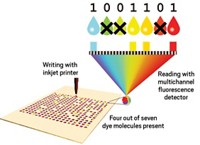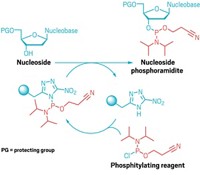Advertisement
Grab your lab coat. Let's get started
Welcome!
Welcome!
Create an account below to get 6 C&EN articles per month, receive newsletters and more - all free.
It seems this is your first time logging in online. Please enter the following information to continue.
As an ACS member you automatically get access to this site. All we need is few more details to create your reading experience.
Not you? Sign in with a different account.
Not you? Sign in with a different account.
ERROR 1
ERROR 1
ERROR 2
ERROR 2
ERROR 2
ERROR 2
ERROR 2
Password and Confirm password must match.
If you have an ACS member number, please enter it here so we can link this account to your membership. (optional)
ERROR 2
ACS values your privacy. By submitting your information, you are gaining access to C&EN and subscribing to our weekly newsletter. We use the information you provide to make your reading experience better, and we will never sell your data to third party members.
DNA
Storing DNA in an amber-like polymer, Jurassic Park–style
Tough, degradable material provides efficient room-temperature DNA storage for genomics and digital data
by Prachi Patel
June 21, 2024

In the blockbuster film Jurassic Park, scientists resurrect dinosaurs by extracting DNA that’s been preserved in amber for millions of years. Inspired by such natural preservation, researchers have created glassy polymers that store DNA at room temperature and dissolve when needed to release the molecules (J. Am. Chem. Soc. 2024, DOI: 10.1021/jacs.4c01925). The method, dubbed thermoset-reinforced xeropreservation (T-REX), is a step toward low-cost data storage in DNA.
Computer memory devices process information as strings of zeros and ones. Those binary data could be encoded in the same four nucleotides—A, G, C, and T—that encrypt genetic information in DNA molecules. Scientists have proposed DNA as a data storage medium because it is dense: a coffee mug full of DNA could store all the world’s data.
But DNA decays in days at room temperature, so it is stored today at cryogenic temperatures, which requires energy and special equipment. “If I wanted to send DNA on a mission to Mars or collect samples in rural Africa, that’s not going to work,” says James Banal, cofounder of Cache DNA, which is developing a new biomolecule storage technology. For room-temperature storage, he and others have previously encapsulated DNA in silica particles and calcium phosphate crystals. This process takes days because water-loving DNA needs to be dissolved in organic solvents using surfactants, which are then removed via drying.
So he, Massachusetts Institute of Technology chemist Jeremiah A. Johnson, and colleagues devised a way to trap DNA in hours, using a hard polystyrene-based thermoset polymer. Thermosets, with their cross-linked polymer networks, are tough and resistant to chemicals. The researchers added small thionolactone sections to the network that can be cut with a cysteamine reagent.
The team made special polycation molecules composed of a water-loving side and an oily water-repellent one. Charges on the molecule bound to DNA and quickly transferred it from water to a solvent containing styrene monomers. Heating the solution created a glassy polymer block containing DNA. The material preserved DNA 10 times as long as silica particles could. Adding cysteamine disintegrated the polymer so the researchers could separate the DNA.
“This work could enable a more widespread application of DNA data storage, as encapsulation and extraction steps are simplified,” says Robert Grass, a chemist at the Swiss Federal Institute of Technology (ETH), Zurich, who was not involved in the current work. More in-depth analysis of the stability of DNA sequences will be needed to assess how the method stands up against current cryogenic techniques, he adds.





Join the conversation
Contact the reporter
Submit a Letter to the Editor for publication
Engage with us on Twitter